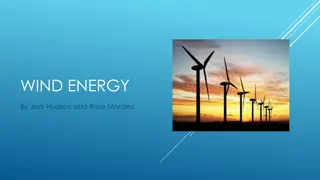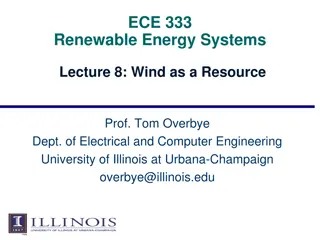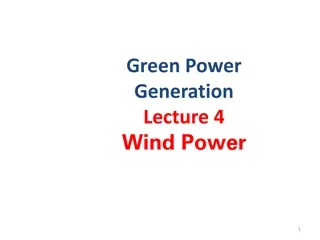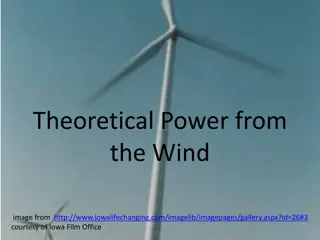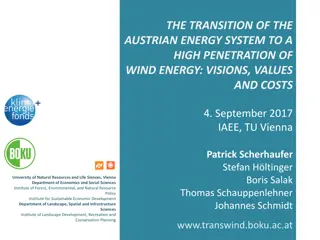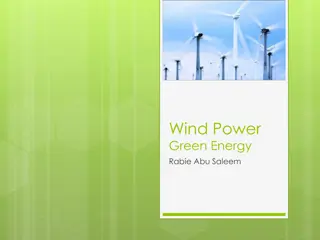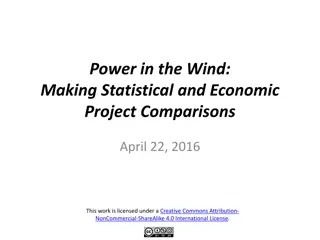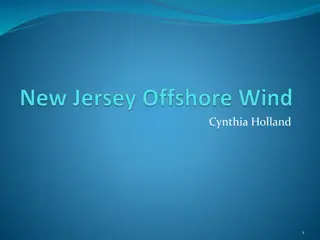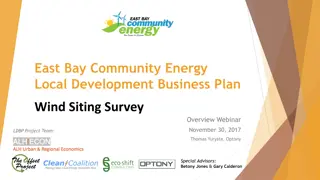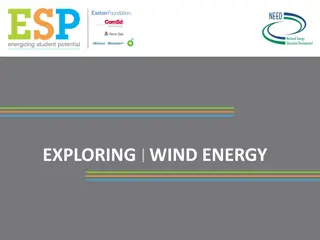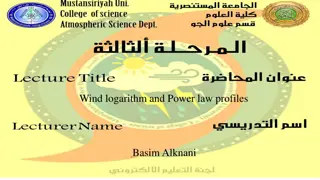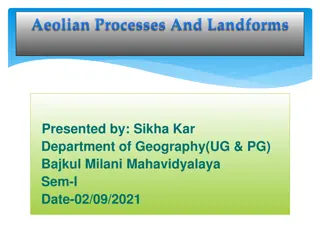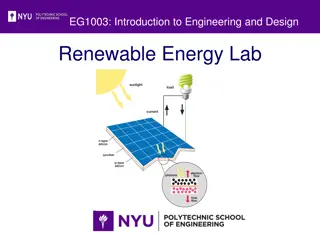Understanding Wind Energy: Benefits, Challenges, and Costs
Wind energy is a clean and abundant resource that offers numerous advantages such as being environmentally friendly, cost-effective, and widely available. However, there are challenges to overcome, including initial investment costs, transmission infrastructure needs, and potential environmental impacts. Despite these challenges, improvements in wind turbine technology have significantly reduced the cost of wind electricity production in recent years.
Download Presentation

Please find below an Image/Link to download the presentation.
The content on the website is provided AS IS for your information and personal use only. It may not be sold, licensed, or shared on other websites without obtaining consent from the author. Download presentation by click this link. If you encounter any issues during the download, it is possible that the publisher has removed the file from their server.
E N D
Presentation Transcript
ECpE Department EE 303 Energy Systems and Power Electronics Wind Energy GRA: Prashant Tiwari Advisor: Dr. Zhaoyu Wang 1113 Coover Hall, Ames, IA wzy@iastate.edu
Wind Energy A wind turbine captures the energy in the natural wind in our atmosphere and converts it into mechanical energy and then into electricity. Wind power was first used centuries ago with windmills, which pumped water, ground grain, etc. Today, highly evolved versions of traditional wind mills, i.e., wind turbines, are extensively used to generate electricity. Modern wind turbines harness the kinetic energy of wind and first convert it to mechanical energy through its blades and then into electrical energy through its generator. Most wind turbines have three blades, which sit on top of a steel tubular tower. Modern wind turbines range in size from 80-foot-tall turbines that can power a single house to utility-scale turbines that are over 260 feet tall and power hundreds of houses. 2 ECpE Department
Benefits of Wind Energy The advantages of wind are manifold. Wind energy is fueled by the wind, and thus, it is a clean energy resource. It does not emit greenhouse gases and also does not pollute the air. Wind energy is a domestic resource of energy and is virtually available abundantly almost everywhere. Similar to solar energy, wind energy is an ultimate source of energy and will not be used up. Wind energy is one of the cheapest renewable energy technologies available today (could be as low as 5 cents per kilowatt-hour). Wind turbines can be built on farms or ranches, which benefits the economy in rural areas. Farmers and ranchers can continue to work the land since the wind turbines use only a fraction of the land. 3 3 ECpE Department ECpE Department
Challenges of Wind Energy Since renewable energies must compete with conventional energy resources, their cost is a very important criterion. Depending on the energy production capability of each wind farm, the wind farm may or may not be cost competitive. However, as the wind energy price has dramatically decreased in the past years, wind farms still need higher initial investment compared to fossil-fueled generators. Highly energetic wind sites are often located in remote and rural locations, far from locations at which the electricity is needed. Transmission lines are required to bring the electricity from the wind farm to cities, which adds to the final price. Although wind power plants have relatively little impact on the environment compared to other conventional power plants, there are some other issues including the noise produced by the rotor blades and also visual impacts. Moreover, in many regions, birds are killed by flying into the rotors. 4 4 ECpE Department ECpE Department
Wind Energy Cost The primary factors determining the cost of electricity from wind energy are: 1) capital costs, 2) capacity factor, and 3) operating costs. Wind turbine technology is improving, which leads to lower-cost wind turbines and better performance, which themselves have reduced the final cost of wind electricity significantly in recent years. Capital Costs: The cost of the wind turbine is the largest cost component, which can be up to 70% or more of the entire cost of a land-based wind farm. Installation cost is responsible for the remaining capital costs. The recent significant reduction in the wind turbine costs have reduced the capital costs. Capacity Factor: A major factor that determines how much electricity will be produced in every wind farm is the strength and quality of the wind resource at that farm. The higher the strength and the quality of the wind is, the more wind energy is produced and the lower the per kW price of the generated wind is. Advancements in technology can also boost the extracted energy from a wind farm. Operating Costs: During its 20 + year lifetime, a wind turbine requires constant monitoring and maintenance to continue to optimally perform. 5 ECpE Department
On-Shore vs Off-Shore Wind Farms There are two main types of wind turbines: 1) on-shore wind turbines and 2) off-shore wind turbines. A combination of several wind turbines is called a wind farm. A wind farm may be consisted of up to hundreds of wind turbines. 6 ECpE Department
Off-Shore Advantages and Disadvantages Off-shore wind energy have several advantages over on-shore wind energy: Coastal regions where off-shore wind turbines may be installed are generally where population is very dense and energy consumption is so high. So, off-shore energy is generated where energy is most needed. Off-shore wind benefits from steadier and higher speeds than onshore winds, leading to more energy generation and more predictability. As technology advances, larger wind turbines will be implemented, which are not so easy to transport via land while their transportation is easier via water. The visual impact of off-shore wind turbines is much less than their on-shore counterparts. Despite all of these advantages, the high cost of off-shore wind turbines is still a prohibitive issue. 7 ECpE Department
Off-Shore vs On-Shore Installation 8 ECpE Department
Off-Shore Turbines 9 ECpE Department
Turbine Size vs Power 10 ECpE Department
Wind Farm Selection Criteria There are several key questions that must be answered before choosing a wind farm location: Is there sufficient wind for the machine to produce usable power at least 50% of the time? What effect will surface terrain have on the wind profile? What barriers might affect the free flow of the wind? Only sites that have annual average wind speed in excess of 5 m/s at 10 m height should be considered. Wind turbines should be 20 to 30 m above ground and at least 10 m above surrounding obstacles. 34 11 ECpE Department
Wind Energy Grid Integration It must be noted the grid integration of wind energy is done via three-phase. 12 ECpE Department
Key Messages Wind energy systems are getting more and more attractive as their price is currently equal to or less than other energy resources. Two type of wind farms exist: 1) onshore and 2) offshore wind farms. Although offshore wind farms can generate more energy compared to thier onshore competitors, but their cost makes them less popular. Wind turbines with power ratings of up to 5MWs have been manufactured, and it is expected to have wind turbines with power ratings of around 20MWs in the future. The maximum extractable power of the wind is limited by Betz limit. To transfer the generated energy of wind turbines to the grid, power electronics systems are essential. 13 ECpE Department
Thank You! 14 ECpE Department


